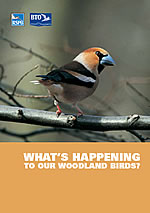WHAT'S HAPPENING TO OUR WOODLAND BIRDS?
 'The Repeat Woodland Bird Survey', the most comprehensive survey of woodland birds in the UK for over 20 years, published by the Royal Society for the Protection of Birds (RSPB) and the British Trust for Ornithology (BTO), were unveiled yesterday by UK Biodiversity Minister Jim Knight,. Here are some of its key findings.
'The Repeat Woodland Bird Survey', the most comprehensive survey of woodland birds in the UK for over 20 years, published by the Royal Society for the Protection of Birds (RSPB) and the British Trust for Ornithology (BTO), were unveiled yesterday by UK Biodiversity Minister Jim Knight,. Here are some of its key findings.* 11 out of the 34 species surveyed [blackcap, blue tit, chiffchaff, coal tit, great spotted woodpecker, great tit, green woodpecker, goldcrest, robin, treecreeper and wren] showed large national increases in numbers (greater than 25%), while eight species [Lesser redpoll, Willow tit, Willow warbler, Spotted flycatcher, Tree pipit, Wood warbler, Lesser spotted woodpecker, Garden warbler, Hawfinch, and Redstart] showed large decreases (greater than 25%) [
* One of the most worrying trends was the decline in long distance migrants, confirmed for the first time in this survey. Among the declining species are: garden warbler, pied flycatcher, redstart, spotted flycatcher, tree pipit, willow warbler, wood warbler. Out of these, the tree pipit and spotted flycatcher showed declines of up to 70% in some areas.
* The report also highlights some resident species in decline: especially the hawfinch, jay, lesser spotted woodpecker (down 59%), lesser redpoll and willow tit. (down 70%). Success stories include the continued growth of more common birds such as coal, blue and great tits and a substantial increase in green woodpeckers [up 200%].
The report concludes that there is no over-arching hypothesis to explain the declines in woodland birds and a range of factors may be at work.
Changes in woodland structure were thought to be one of the key drivers to some of the changes, although factors behind this are unclear. Possible areas of research to develop this further include looking at changes in woodland age, and active management of woodland, and for some specific species further research into the impact and increases in deer browsing, and for some species the impact of grey squirrel populations..
The research was commissioned and funded by Defra, the Forestry Commission, RSPB, BTO, the Woodland Trust and English Nature. It was carried out with the support of the UK Woodland Bird Group – a forum that brings together a wide range of organisations concerned about the issue.
The study covered 406 woodland sites, and uniquely allows data comparison with similar surveys carried out in the 1960s, 1970s and 1980s. This enables the development of a comprehensive picture of the status and health of our woodland bird diversity, and to analyse trends and developing concerns. It also establishes a comprehensive benchmark for woodland bird population research. This is important because wild bird populations are one of the Government’s 15 headline indicators of sustainable development. The reverse of the long-term decline in the numbers of woodland birds is one of the key objectives of the UK Biodiversity Action Plan.
A PDF of the full report can be found here: www.forestry.gov.uk/woodlandbirdsurvey
The Woodland Birds conference will be held at the University of Leicester on 1 – 3 April 2006. Topics planned for discussion at the conference include the impact of climate change on populations, forest and woodland management, comparisons with European and wider international bird population developments, and specific species focuses on woodpeckers, willow and marsh tits, tree pipits and grouse. Further details of the agenda and events, and a booking form are available online at http://www.bou.org,uk/

0 Comments:
Post a Comment
<< Home